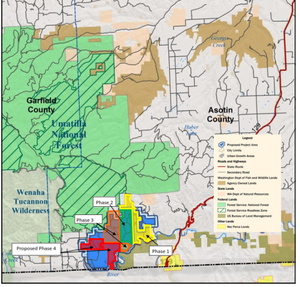State buys wildlife land, updates rules on work near waters
WILDLIFE MANAGEMENT -- The Washington Fish and Wildlife Commission voted to buy more 4-0 Ranch land along the Grande Ronde River and updated rules for work that impacts state waters during a meeting last week in Olympia.
The commission approved the purchase of 2,005 acres of riparian and high meadow lands in Asotin County, the latest deal in a six-phase decade-long real estate program to buy nearly 12,000 acres of the Odom/4-O Land & Livestock, LLC.
The land will be purchased with $3.6 million in state and federal funding and be added to the the 6,431 acres the state already has acquired from rancher Milt (Mike) Odom II. The funding sources include the Washington Recreation and Conservation Office and a grant from the U.S. Fish & Wildlife Service.
The state Department of Fish and Wildlife is acquiring the land to expand the Chief Joseph Wildlife Area of the Blue Mountains Wildlife Area Complex and preserve critical habitat for threatened salmon, steelhead and trout, as well as deer, bighorn sheep and elk.
The new acquisition, when closed with the 4-O Land & Livestock, LLC, will include a mile-long section of the Grande Ronde River and stretches 1.5 miles on either side of Wenatchee Creek.
“This acquisition contains some of the best wildlife mosaic currently available. Historically, the property has been managed as a working ranch with a focus on wildlife habitat providing trophy big game hunting opportunities. Management practices include scattered dry land farming, moderate cattle grazing and timber production. The value of this property includes riparian habitats beneficial to endangered fish species and forestland and high meadow complexes beneficial to ungulates including bighorn sheep, deer and elk,” said Julie Sandberg, WDFW real estate manager.
Past stories related to the 4-0 Ranch acquisitions include:
- Landers: Saving wildlife habitats critical, 2014
- Washington’s Fish and Wildlife riles Asotin County with land buys, 2014
- Land acquired for wildlife conservation in 2013, 2014
- New wildlife land in Asotin County off-limits to some hunters, 2012
- State acquiring land along Grande Ronde River, 2011
The commission also approved dozens of changes in the statewide hydraulics rules during a public meeting on Friday and Saturday. Common projects requiring approval under the state's hydraulic rules include work on bulkheads, culverts, piers and docks.
Miranda Wecker, who chairs the commission, said the revised hydraulic code rules reflect developments in environmental science, technology, and state law since the last comprehensive update in 1994.
The updated rules also “reflect the department's efforts to streamline the application process for permits required to conduct work in and around state waters," she said.
Some of the rules proposed by WDFW set new standards for projects ranging from culvert design to decking materials that allow light to penetrate to the water below. Others clarify existing policies, including a statewide ban on the use of creosote in aquatic areas.

